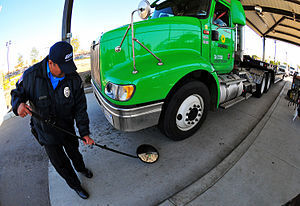Security and Access Control (Ingress and Egress)

April 02, 2015 - PSPA Editorial Staff
Introduction
A fundamental yet significant responsibility of most Security Officers/Departments is to control access (ingress and egress) to a facility, building, or area. The key purpose of controlling access is to ensure that only authorized personnel, vehicles, and materials are allowed to enter, move within, and leave the facility. Effective access control provides increased protection of personnel and property within the facility as well as increased protection of the facility itself. Security Officers, by their mere presence coupled with their overall demeanor and policy compliance can effectively deter criminal activities and/or violations of company policy. As a rule-of-thumb, a Security Officer’s fundamental responsibility is to detect, deter, observe, and report.
Why Control Access
In general, most Security Officers are charged with deterring unwanted activities or incidents against the people who work or visit client owned or controlled facilities as well as the property contained within. Effective ingress/egress control can prevent countless intentional as well as unintentional accidents, injuries, property loss and property damage in addition to violations of the law as it pertains to people and property.
Ingress and Egress can be controlled by Security Officers and/or in conjunction with the use of Physical Equipment including but not limited to: doors, gates, barricades, man-traps, locks, access cards, identification badges, intrusion alarms, metal detectors, vehicle inspection mirrors, vehicle weight stations, bill of lading inspections and associated sign-in/out logs to name just a few. Security measures will vary according to the facility, location/area being protected as well as the type of facility being protected.
Each facility, building/area can present separate risk factors based upon a number of variables including but not limited to the type of business and occupants. Levels of ingress/egress control must be developed, implemented, and stringently managed accordingly. In most cases, the Security Officer will be charged with enforcing access control procedures while simultaneously detecting, deterring, observing, and reporting.
General Considerations
A variety of people will require ingress to and egress from secured facilities. These people include employees, contractors, vendors, emergency personnel, and the general public. Security Post Orders must detail procedures that facilitate a smooth operation for all personnel concerned, whether entering or departing. The procedures should instruct officers how to present a perception of “Safety” and “Security” while at the same time, discouraging policy violations or criminal activity.
Countless procedures exist to effectively manage entry to a facility, building/area. Open access and egress is used for buildings and common areas where there is no need for control, and people may come and go as they please. In areas where access control is required, there are several fundamental procedures that can be established to meet the needs, based upon location and type of facility. Several examples include:
Use of employer issued Identification Badge
Use of employer issued Key and/or Access Card
Presentation of a valid photographic identification
Approved entry vetted against an agency provided access list
Approved entry with sponsor/escort
High risk/threat locations may require personnel to walk through a magnetometer and possessions be processed through an x-ray machine. The machines are designed to detect the possible presence of weapons, incendiary devices, or other prohibited items/material. Security Officers may also be required to inspect other items such as laptop computers, and cellular telephones.
People Considerations
During the screening process it is important that Security Officers be familiar with the beliefs and customs of different cultures and religions. Visitors to the facility may be dressed in cultural or religious garments and/or be in possession of religious articles. The following considerations should always be afforded while conducting a search of someone wearing or carrying cultural or religious articles:
Visually post written screening protocols
Verbally explain why you need to conduct a security search
Show respect to all variations of faith during inspections
Searches should be conducted by a Security Officer of the same gender
A culturally diverse and sensitive Security Officer may prevent embarrassing situations and portray the client in a positive light.
As a rule-of-thumb, Security Officers must act as Goodwill Ambassadors as their actions or inactions can make or break the overall reputation of the entire organization.
(Photo:) A uniformed Security Officer conducts an undercarriage inspection of a commercial vehicle {with a hand-held extension mirror} at an undisclosed ingress/egress security check station.






